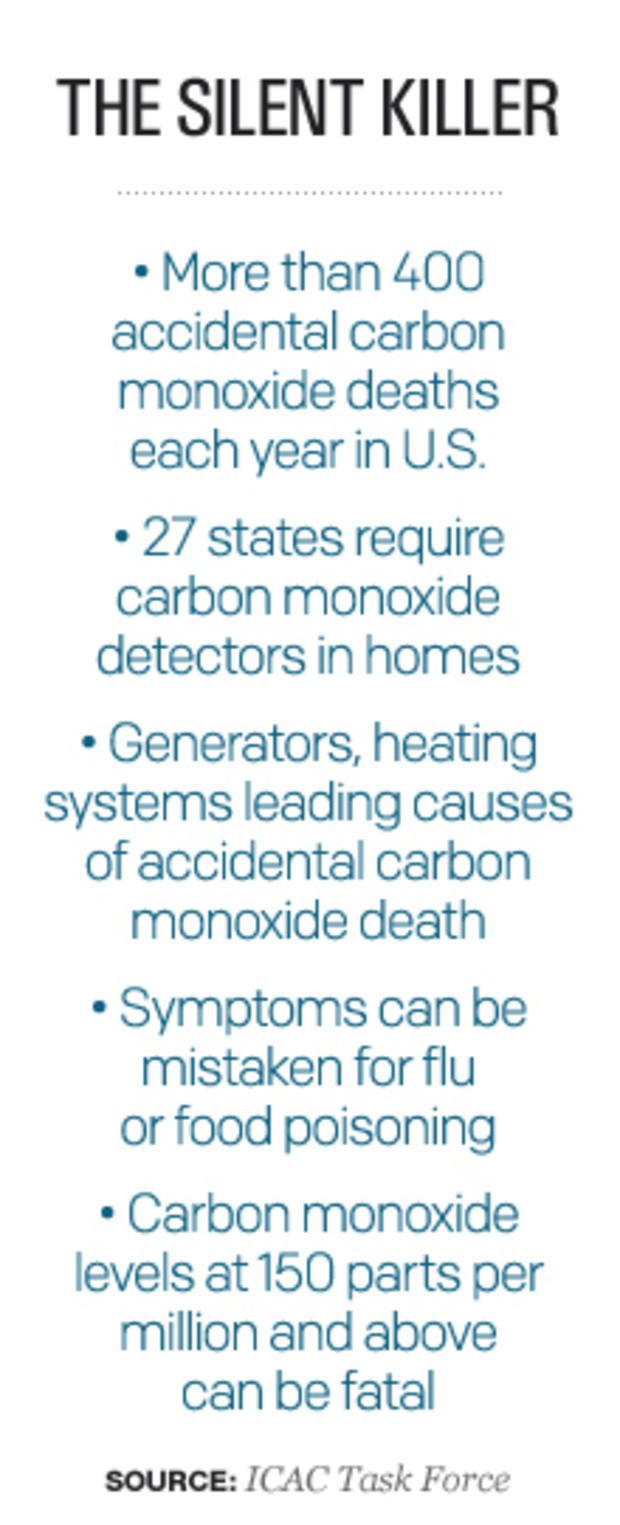Hotel deaths highlight often undetected killer
It seemed, at first, like a mystery: Why did three people - an elderly couple and then, two months later, an 11-year-old boy - die in the same North Carolina hotel room?
In the absence of obvious evidence, some Internet commenters blamed "the spooky side of things" and raised the specter of a "haunted" hotel in the immediate aftermath of the third death. The reality, officials later revealed, was nothing so fantastical: The victims had been exposed to elevated levels of carbon monoxide, an odorless, colorless gas that results in hundreds of accidental deaths in the United States every year, according to the Centers for Disease Control and Prevention.
Carbon monoxide, nicknamed the "silent killer" because it is nearly impossible to detect without equipment, is produced by appliances and other items that often generate combustion fumes - generators, furnaces, water heaters, automobile and boat engines, space heaters, grills, fuel-powered tools. When carbon monoxide is concentrated in an enclosed space it displaces oxygen in the blood, depriving vital organs. It can lead to serious tissue damage and death, with victims losing consciousness and suffocating within minutes of exposure.
Many people exposed to carbon monoxide may assume the symptoms, which can include headaches, fatigue and vomiting, are tied to something else: A flu or tainted food, perhaps. And for many doctors, "the last thing that they think of is carbon monoxide," said Bob Dwyer, director of training for the Carbon Monoxide Safety Association.
"One of the biggest problems is the lack of adequate education of physicians and emergency responders," said Dr. David G. Penney, an expert on carbon monoxide poisoning and retired professor at Wayne State University. "They think it might be a drug overdose or hypoglycemia or food poisoning."
Fuyuen Yip, an epidemiologist with the CDC, said the carbon monoxide poisoning is difficult to diagnose "because a lot of the symptoms are very non-specific."
For reasons that are not yet clear, officials in North Carolina did not identify carbon monoxide as the culprit in the deaths of the elderly couple, Daryl Dean Jenkins, and Shirley Mae Jenkins, in the hotel room two months ago until after the death of 11-year-old Jeffrey Williams. Dwyer said he believes many deaths of elderly Americans are caused by carbon monoxide without anyone realizing it.
"Older people don't get autopsied," he said. "And there's probably a lot of people who have died from chronic low-level carbon monoxide that probably went to their graves with that secret."
There is no nationwide requirement for carbon monoxide alarms in homes or private buildings. North Carolina is one of 27 states that require the alarms in new homes, but they are not required in hotels. A USA Today investigation in January found that more than 170 hotel guests have undergone treatment due to carbon monoxide poisoning over the past three years, and eight have died.
Patty Davis of the Consumer Products Safety Commission, which is investigating the deaths in North Carolina, said he group supports efforts to require carbon monoxide detectors, which can cost less than $20 for lower-end models. "Carbon monoxide alarms can save lives," she said. "We urge consumers to install working carbon monoxide alarms in their homes and hotels to install them as well."
Though there is not currently routine reporting of accidental carbon monoxide deaths in the United States, the CDC reports an average of 439 accidental, non-fire related deaths domestically each year from 1999 to 2004. The Consumer Products Safety Commission reported 146 accidental carbon monoxide deaths from the products it covers - which does not include automobiles, among other items - in 2009. The leading causes of death were generators and heating systems.
The CDC stresses that people should never use generators or grills indoors and not use a gas range or oven for heating. (Many carbon monoxide deaths take place during power outages.) It also urges people to regularly have their combustion appliances serviced. There is early speculation that a natural gas heater for a swimming pool may have been the source of the carbon monoxide at the North Carolina hotel.
"The CDC definitely recommends that homeowners install a battery-powered CO detector or a CO detector that has a battery backup somewhere near where they sleep," said Yip.
Carbon monoxide is already common at low levels in many settings: Dwyer said that during a visit to New York City recently, his test sensor never showed less than 10 parts per million in carbon monoxide, either indoors or out. Those who work in enclosed spaces with combustion devices present are at particular risk. According to the Consumer Products Safety Commission, symptoms are most likely to kick in at 70 parts per million; concentrations at 150 parts per million or above can bring unconsciousness and death.
Penney said the incident in North Carolina and other fatalities are tragic illustrations of the gaps in monitoring of carbon monoxide levels.
"It can be done so really inexpensively," he said, "and it saves lives."
N.C. Hotel Deaths Update: Carbon monoxide found in room where 3 died over 2 months, officials say
